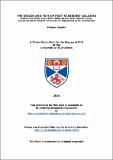Files in this item
The origin and fate of post-starburst galaxies : morphological and structural image analysis of local galaxies with recent episodes of enhanced star formation
Item metadata
| dc.contributor.advisor | Wild, Vivienne | |
| dc.contributor.author | Pawlik, Milena | |
| dc.coverage.spatial | xxv, 183, [7] p. | en_US |
| dc.date.accessioned | 2016-11-29T14:14:17Z | |
| dc.date.available | 2016-11-29T14:14:17Z | |
| dc.date.issued | 2016 | |
| dc.identifier.uri | https://hdl.handle.net/10023/9902 | |
| dc.description.abstract | Post-starburst galaxies are a rare class of objects with unusual spectroscopic characteristics. Previous studies have shown that the presence of strong Balmer absorption lines in the spectra of these galaxies are consistent with a recent bust of star formation; however, the cause of such events remains unclear. Their environment and disturbed morphology suggest that many of them are likely remnants of gas-rich mergers of galaxies with comparable masses and models of galaxy mergers support that claim; however, some studies disagree and the origin of these curious systems remains an open debate. Post-starburst galaxies are also often regarded as a plausible transition channel between the blue continuously star-forming and quiescent red galaxies, commonly observed in the local Universe. This is supported by models of merger- driven starbursts, which cause structural transformation of galaxies consistent with evolution towards the red population, and can ultimately lead to quenching of star formation in the merger remnant; however, observational evidence for this scenario remains elusive. In my study I aimed to place further constraints on the role of galaxy mergers in triggering starbursts in local galaxies and to investigate whether the post-starburst galaxies are indeed in transition between the star-forming and passive phases of galaxy evolution, by the analysis of the morphology and structure of galaxies with spectroscopic signatures of a recent starburst. An important difference between this work and many previous studies is the post-starburst sample selection. Traditionally, post-starburst galaxies are selected to have completely quenched their star-formation; here, I also considered those which show spectroscopic sign of residual star-formation, selected using a method introduced by Wild et al. (2007). I have also followed a different approach to quantifying the morphology of galaxies, by means of an automated method for detecting visual post-merger signatures in galaxies, introduced as a part of this work. My analysis suggests that major mergers play a significant role in inducing starbursts in local Universe, but their significance declines as a function of the stellar mass of the galaxies. I also found that post-starburst galaxies have different structural properties in the low- and high-mass regimes and concluded that they are likely to be transitioning between the blue and red galaxy populations through a multi-stage scenario where both major and minor mergers are at play. | en_US |
| dc.description.sponsorship | European Career Reintegration Grant Phiz-Ev (P.I. Vivienne Wild) | en_US |
| dc.language.iso | en | en_US |
| dc.publisher | University of St Andrews | |
| dc.subject.lcc | QB806.P28 | |
| dc.subject.lcsh | Stars--Formation | |
| dc.subject.lcsh | Galaxies--Evolution | |
| dc.title | The origin and fate of post-starburst galaxies : morphological and structural image analysis of local galaxies with recent episodes of enhanced star formation | en_US |
| dc.type | Thesis | en_US |
| dc.contributor.sponsor | Science and Technology Facilities Council (STFC) | en_US |
| dc.contributor.sponsor | European Commission. | en_US |
| dc.type.qualificationlevel | Doctoral | en_US |
| dc.type.qualificationname | PhD Doctor of Philosophy | en_US |
| dc.publisher.institution | The University of St Andrews | en_US |
This item appears in the following Collection(s)
Items in the St Andrews Research Repository are protected by copyright, with all rights reserved, unless otherwise indicated.

